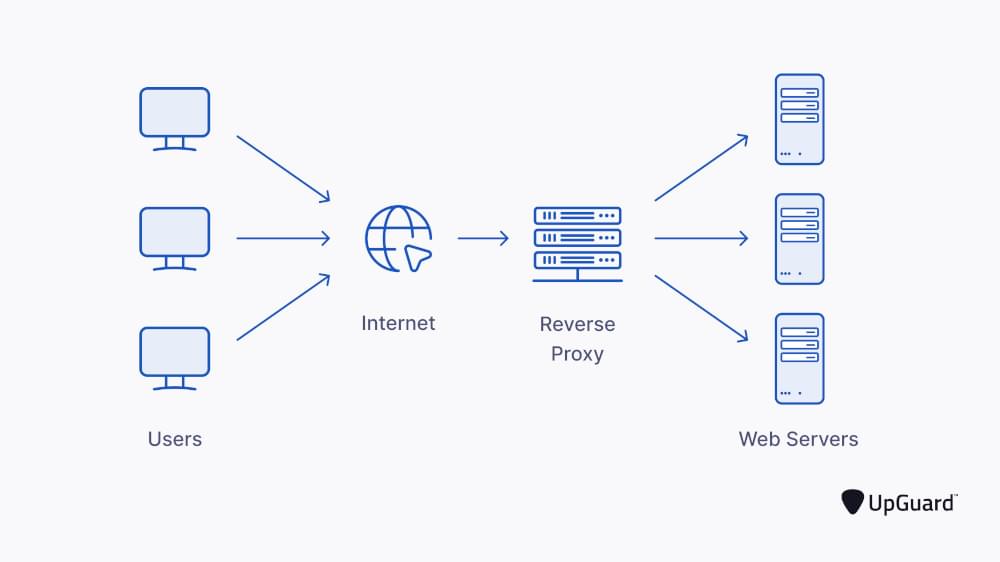Reverse proxies, no doubt, have emerged as a powerful tool and hold significant importance in optimizing your website’s performance as they redirect user requests to the right backend server.
We assume that you are familiar with the concept of reverse proxying and its working principle as well. However, for your convenience, we have included a diagram below so you may quickly recall its concept.

We have discussed the advantages of proxy servers, but what are the benefits of using a reverse proxy?
This blog outlines the most important advantages of using a reverse proxy that you should be familiar with.
We have gathered the primary advantages of reverse proxy servers that you might want to know about.
1. Load is Balanced
Reverse Proxy minimizes the traffic load on the website by efficiently distributing the incoming traffic across multiple servers and ultimately balancing the load. This is the primary benefit of reverse proxy, among other benefits of reverse proxying, to enhance the uptime and accessibility of the website and increase productivity. Thus, in the event of a server shutdown, the proxy will automatically redirect the user request to the next available server so that the user can continue accessing the website or application without any interruption. Reverse proxies are used by 24% of the total websites on the internet, so balancing the load for this portion of the websites can be a daunting task, but not for reverse proxy servers.
2. You are Secure and Your Data too
Security benefits of reverse proxy are undoubtedly the most important ones. Using it will enhance security and shield the backend servers from direct exposure. It even secures your sensitive and confidential data and services, as it only puts forward the requests that you want and makes sure that your backend services are not visible outside your own network.
3. Scalability and Flexibility
Reverse proxying plays a significant role in providing scalability as well as flexibility in web applications. The load balancing feature helps a lot in achieving scalability and flexibility by adding and removing servers according to traffic volume without any interruption. This particular advantage of using reverse proxy increase web applications’ availability and optimize their general performance.
4. Communication is Encrypted through SSL encryption
Another key advantage of using a reverse proxy is that it provides SSL encryption for quick and secure communication between users and backend servers. As a result, they receive users’ encrypted HTTP requests and decrypt them before sending them to backend servers. This saves the backend servers from being burdened with SSL encryption. Moreover, the advantages of reverse proxy servers are not just limited to encrypted communication. Its SSL encryption feature aids in protecting the web servers from exposure to potential security risks and provides defenses against risks like man-in-the-middle attacks, among others.
5. Everything is Filtered and Monitored Before it Reaches You
Reverse proxies have the capability to monitor and filter the content to gain insights into the web application and user behavior to detect security threats. They can gather valuable insights based on traffic patterns, metrics, and response times, and monitor traffic patterns, for troubleshooting and other data analysis.
6. Enhanced Efficiency and Performance
Reverse proxies achieve high efficiency and performance by optimizing page load time and reducing bandwidth and the general load on the server. Caching and compression are the two main approaches it follows to achieve high efficiency and performance.
Caching: Provides quicker data retrieval by storing frequently used data at the proxy level.
Compression: It compresses data before returning it to consumers to reduce overall bandwidth.
It is estimated that each proxy server can handle upto 125 million cache requests in 24 hours.
7. Single Entry Point
Since the reverse proxy server must process each request, it serves as a single point of entry. In addition to streamlining the network architecture, using it also eliminates the need to manage multiple servers and monitor incoming requests in order to implement security policies, manage traffic, and impose authentication and authorization strategies.
Being a single entrance point has several advantages because it is cost-effective and requires minimal maintenance. Furthermore, this single entry feature adds to the security benefit as the proxy rejects and limits the unknown traffic coming towards web servers to ultimately, provide protection from DDoS attacks and cyber threats.
8. Global server load balancing
Another advantage of using a reverse proxy server is that it implements a global load balancer that helps redirect the incoming traffic to servers globally. Reverse proxies with global server load balancing (GSLB) manage large volumes of traffic by redirecting it to the nearest server based on location, server load, network conditions, or predefined routing policies. This improves performance and availability, which in turn improves user experience and enables scalable infrastructure.
9. Real Time Testing Environment for Web Applications
Let us tell you that reverse proxying enables you to test your web apps. We’re not kidding.
Reverse proxies actually play a significant role in testing web applications they enable A/B testing, load testing, modeling production environments, and even offer test environment isolation. Through these methods, you can gain insights into how your product will perform and function under different traffic volumes, which in turn helps you identify scalability problems. Furthermore, you can also get real-time user feedback. The advantages of using reverse proxy are beyond what we expect.
Aren’t the advantages of reverse proxy server surprising?
That was all, folks!
In this blog, we shared many of the key benefits of a reverse proxy server, including the security benefits of reverse proxy that you can achieve after implementation. These benefits are essential for optimizing website architecture.
Any organization should consider these benefits, which range from increased security to improved performance, scalability, seamless user experiences, assurance of the availability of business services, and much more.











